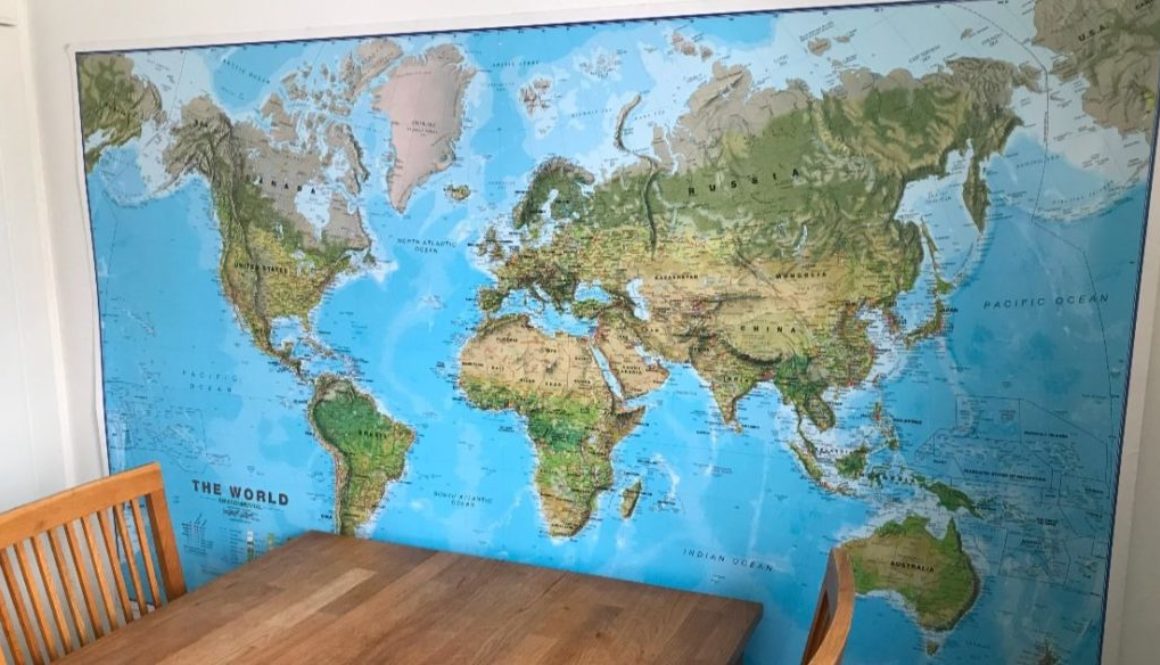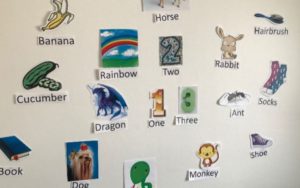Making learning part of your interior design

Would you consider using your wall space for learning? What conversations would begin in your home if you had visual triggers that drew your curiosity during moments when your mind is wandering?
When I was in my twenties my sister and I talked about the world. How huge it is in some aspects and how small in others. I mean.. the globe is enormous but there are truly a limited number of countries out there. Depending on the source, and political viewpoint, it ranges between about 190-195. We became curious to find out if we could learn all these countries. To name and place all 195 of them as well as remember their capitals.
We drew maps and created question cards with a name of a country on one side and the capital on the other. To more easily remember some names we created crazy rhymes and “stories” about them. To this day I know that the capital of Sudan is Khartoum. The reason is that our old dog named Sudden loved eating cardboard which in Swedish is called “kartong”.
Creating hooks to hang knowledge on
As the days and weeks went by we realized that we’d created something more than a neat party trick, “name any country and I’ll tell you its capital”. We both got the feeling that the world became more alive. As I began to internalize the continents I got the feeling of zooming in and out of the world map. My sister would test me for the capital of Cambodia and my mind would zoom in on that. Then it would zoom out and over the ocean to the next country she asked about. I remember feeling that zoom physically as well as hearing a quiet buzz in my head as the “lens” got focused on the country in question.
Learning the geographical place of a country and its name and capital created a “hook” in our minds. This hook served as a hanger that we could hang other knowledge and learning on. It’s way easier to remember that Machu Picchu lies in Peru now that I know where Peru is. In brain science it’s said that “Neurons that fire together wire together”. When you repeat knowledge your neurons fire in a certain order and pattern. Each time your brain gets a little more effective at firing in that specific order. If you create a strong starting point for a network of neurons a.k.a. the first two or three facts about something, then you can relatively easily add more fact to that neuron chain.
Learning is automatic when it’s borne out of curiosity
The best learning I’ve experienced with my daughters have been around our kitchen table. We eat both breakfast and dinner together. I always try to make sure we have enough time to allow us to actually talk and connect. I’ve promised myself that I will never use that time for interrogation, corrections or reactive problem solving. Focus when we’re in the kitchen is to laugh, talk about whatever comes naturally and to connect. Spending time in the kitchen should always be anchored to being safe to tell the truth. I want them to be able to ask anything they want and to feel loved and listened to. When we manage to get into that feeling together something magical happens; curiosity awakens.
 I’ve used the walls and the doors to our cupboards in the kitchen as a space to place visual triggers for learning. When my girls were starting to learn English I printed color pictures of words they might like. I printed cards with the names in English and put a reusable adhesive on the back of all of them so we could move them around. Some mornings we had only pictures of animals on the wall, some mornings only words so the girls could find the right picture for each word. Without fail I could change the pictures and one or both of them would notice and be drawn to working with the words. Sometimes they would ask me to test them on the words during dinner. They pay attention to what’s in front of them and their curiosity is automatic.
I’ve used the walls and the doors to our cupboards in the kitchen as a space to place visual triggers for learning. When my girls were starting to learn English I printed color pictures of words they might like. I printed cards with the names in English and put a reusable adhesive on the back of all of them so we could move them around. Some mornings we had only pictures of animals on the wall, some mornings only words so the girls could find the right picture for each word. Without fail I could change the pictures and one or both of them would notice and be drawn to working with the words. Sometimes they would ask me to test them on the words during dinner. They pay attention to what’s in front of them and their curiosity is automatic.
Focus on getting them thirsty instead of trying to make them drink
I used to believe that as the parent I should be the teacher for my girls, be the one with all the answers. I’ve realized however that there’s just no way that I would be able to keep up with all the learning that they are doing and instead I’ve begun to focus on creating a positive atmosphere for their own learning.
 On the windowsill we have a lamp in the shape of a globe. It’s Earth lit up from the inside, giving a soft glow to our kitchen during our winter mornings. We also have a large, 1*1,5 meter, world map on the wall. These two together have been the start of many conversations regarding traveling, geography and coordinates systems as well as historical and political questions.
On the windowsill we have a lamp in the shape of a globe. It’s Earth lit up from the inside, giving a soft glow to our kitchen during our winter mornings. We also have a large, 1*1,5 meter, world map on the wall. These two together have been the start of many conversations regarding traveling, geography and coordinates systems as well as historical and political questions.
It’s hard to resist the map when it’s so huge and so colorful. You’re drawn to it and it puts things in perspective. Here we are, a small dot in a country that constitutes just a little corner of the world.
We’ve been through some really interesting questions and it amazes me how much they already know. I also love how unlimited and open they are in their perception of the world.
- Where would we like to visit?
- What date and time is it at different places?
- What kind of weather is there in different places and why does the seasons affect us differently?
- Why does the map on the wall have Europe in the “middle” and do all maps look like that?
- Can you get to all places on earth?
Dedicate your interior design to learning
Humans have different preferred ways of learning. Some like to read, some like to hear or see to understand and yet others learn best if they get to practice something physically. The most effective way is to combine as many senses as possible and one way to facilitate this, in everyday life, is to use your home space for visual triggers.
Maybe you can decorate your walls with knowledge and inviting photos and concepts? Maybe a photo wallpaper depicting a forest or a grand view over a city or even space? Use your living space in a way that encourage dreaming and that nurture that valuable curiosity.
